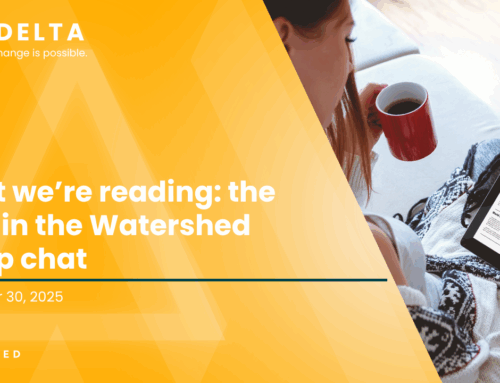The Delta Issue #18
Our answer to “Why didn’t this policy work?”
By: Kunjan Narechania
Hi everyone, Kunjan Narechania here. Last week, Jessica Baghian shared some great advice on creating a coherent, specific vision for change. (I’ll link to that issue here.) Never has it been more important for states to articulate a coherent vision for kids in their schools. This week, I’m here to talk about why your vision should include a detailed map of how adult behavior needs to change in order for kids to experience this new vision – or what we at Watershed Advisors call the implementation chain.
If you’ve worked in education for as long as I have, there’s a good chance you have seen a scenario like this play out with your own eyes: A state passes a widely popular education policy with the promise to transform what kids experience in classrooms. When the bill is signed, everyone is excited about the big win for students.
A year later, state officials plan a school visit, eager to see the new policy in action. But to their dismay, everything is exactly the same as it was.
Those new curriculum materials? They made it to the school, but they’re still in boxes, stacked against the wall collecting dust.
Everyone is scratching their heads. Why aren’t schools implementing the new policy?
It’s not because the policy wasn’t good. It’s not because teachers don’t want to support their students. And it’s not because students don’t want to learn. It’s because there was a breakdown in the implementation chain, the sequence of adults whose behavior has to change in order for students to experience something different in the classroom.
Good policy is intended to change student experience in a way that will lead to greater achievement or attainment. But too often in our country, we pass policy and then measure whether students learned more — paying little attention to what happens in the middle. That’s why mapping out the implementation chain is so important — it’s how you get to the level of specificity and alignment required to go from concept to the classroom.
Here’s an example of an implementation chain should look like for a state that has just passed a science of reading policy:

Without identifying the specific, highest-leverage behavior changes of every adult in the implementation chain that will lead to the improved student experience, it is very difficult – if not impossible — to turn even the best policy into reality.
Here are three real-world examples of how to turn vague platitudes into specific behavioral changes:

Outlined above is the start of an implementation chain that ultimately should extend to include any educator involved in supporting literacy instruction — but you get the picture.
This chain is not one-size fits all, and it’s not about controlling everyone’s behavior. It may be that one district has moved past some of these actions, and another needs to slow down. But every district needs a roadmap. Naming the specific behaviors that adults need to change allows state and district leaders to align their work to elicit these specific behaviors, while also allowing for some on-the-ground adjustment. This level of detail also offers benchmarks for states to measure and scale behavior change, which is essential to making sure your vision is actually changing the lives of students in classrooms. (We’ll dive more into measurement in a future issue of the Delta).
Let’s Get Muddy
The team at Watershed Advisors maps out an implementation chain for every policy we work on. Want to try it out for yourself? Try answering these questions:
If your policy is implemented well, what will students be doing in the classroom?
Next, map the adults: What will teachers need to do for students? What does this mean principals need to do for teachers? What does this mean districts need to do for principals? And what does this mean the state needs to do for districts?
Want our feedback on yours? Drop it in the comments below!





